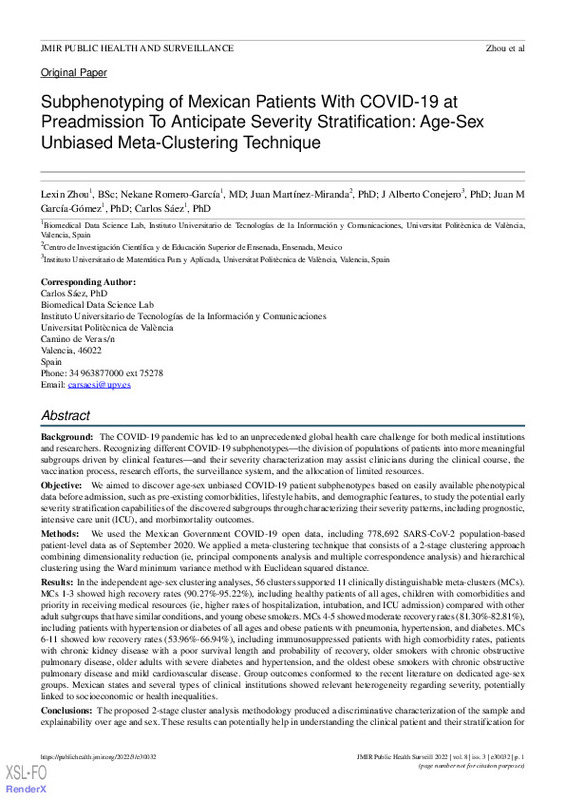|
Resumen:
|
[EN] Background: The COVID-19 pandemic has led to an unprecedented global health care challenge for both medical institutions and researchers. Recognizing different COVID-19 subphenotypes-the division of populations of ...[+]
[EN] Background: The COVID-19 pandemic has led to an unprecedented global health care challenge for both medical institutions and researchers. Recognizing different COVID-19 subphenotypes-the division of populations of patients into more meaningful subgroups driven by clinical features-and their severity characterization may assist clinicians during the clinical course, the vaccination process, research efforts, the surveillance system, and the allocation of limited resources. Objective: We aimed to discover age-sex unbiased COVID-19 patient subphenotypes based on easily available phenotypical data before admission, such as pre-existing comorbidities, lifestyle habits, and demographic features, to study the potential early severity stratification capabilities of the discovered subgroups through characterizing their severity patterns, including prognostic, intensive care unit (ICU), and morbimortality outcomes. Methods: We used the Mexican Government COVID-19 open data, including 778,692 SARS-CoV-2 population-based patient-level data as of September 2020. We applied a meta-clustering technique that consists of a 2-stage clustering approach combining dimensionality reduction (ie, principal components analysis and multiple correspondence analysis) and hierarchical clustering using the Ward minimum variance method with Euclidean squared distance. Results: In the independent age-sex clustering analyses, 56 clusters supported 11 clinically distinguishable meta-clusters (MCs). MCs 1-3 showed high recovery rates (90.27%-95.22%), including healthy patients of all ages, children with comorbidities and priority in receiving medical resources (ie, higher rates of hospitalization, intubation, and ICU admission) compared with other adult subgroups that have similar conditions, and young obese smokers. MCs 4-5 showed moderate recovery rates (81.30%-82.81%), including patients with hypertension or diabetes of all ages and obese patients with pneumonia, hypertension, and diabetes. MCs 6-11 showed low recovery rates (53.96%-66.94%), including immunosuppressed patients with high comorbidity rates, patients with chronic kidney disease with a poor survival length and probability of recovery, older smokers with chronic obstructive pulmonary disease, older adults with severe diabetes and hypertension, and the oldest obese smokers with chronic obstructive pulmonary disease and mild cardiovascular disease. Group outcomes conformed to the recent literature on dedicated age-sex groups. Mexican states and several types of clinical institutions showed relevant heterogeneity regarding severity, potentially linked to socioeconomic or health inequalities. Conclusions: The proposed 2-stage cluster analysis methodology produced a discriminative characterization of the sample and explainability over age and sex. These results can potentially help in understanding the clinical patient and their stratification for automated early triage before further tests and laboratory results are available and even in locations where additional tests are not available or to help decide resource allocation among vulnerable subgroups such as to prioritize vaccination or treatments.
[-]
|
|
Agradecimientos:
|
We sincerely thank the different types of clinical institutions and the Mexican government, which made a huge effort to make these data publicly available. We also thank the clinicians and epidemiologists from the Servicios ...[+]
We sincerely thank the different types of clinical institutions and the Mexican government, which made a huge effort to make these data publicly available. We also thank the clinicians and epidemiologists from the Servicios de Salud de Nayarit for the useful discussions on specific aspects of the medical attention to hospitalized patients and the reporting of epidemiological data processes related to COVID-19. Furthermore, we would also like to thank Francisco Tomas Garcia Ruiz for his valuable help in data visualization design. This work was supported by Universitat Politecnica de Valencia contract no. UPV-SUB.2-1302 and FONDO SUPERA COVID-19 by CRUE-Santander Bank grant: "Severity Subgroup Discovery and Classification on COVID-19 Real World Data through Machine Learning and Data Quality assessment (SUBCOVERWD-19) ." The authors thank the Institute for Information and Communication Technologies (ITACA) at the Universitat Politecnica de Valencia for its support in the publication of this manuscript.
[-]
|









